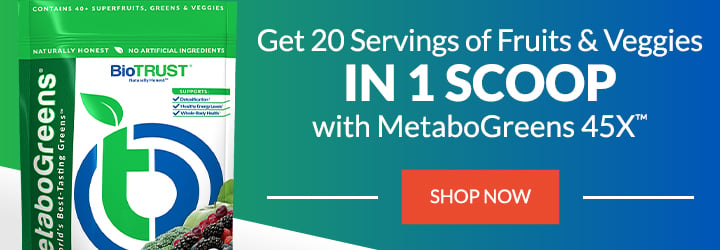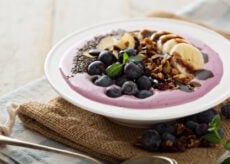Cauliflower vs. Broccoli: What Vegetable Is Better for You?

Cauliflower and broccoli are the perfect partners, often being seen side by side as companions or as family members that can be used interchangeably. Whether you are reaching for cauliflower vs. broccoli, they are both nutritious options that fall within the category of cruciferous vegetables.
Although these two tree-like vegetable are related, they are not identical. They both have their own set of health benefits, and besides their visible color differences, broccoli and cauliflower have some very distinct variations.
What are Cruciferous Vegetables?
Cruciferous veggies include a diverse group, including broccoli and cauliflower (of course) as well as cabbage, kale, bok choy, arugula, Brussels sprouts, collard greens, watercress, and radishes. The name itself (cruciferous) is due to how it looks and is an informal classification for members of the mustard family. The four petals resemble a cross, and the name comes from the Latin Cruciferae, meaning “cross bearing.”
Cruciferous vegetables are found in a wide variety of colors, shapes, and sizes; however, they all share several nutritional benefits. For instance, most cruciferous vegetables are rich in vitamins and fiber and low in calories, which means they can help you feel fuller and more satisfied after eating.
Cauliflower vs. Broccoli
Health Benefits of Broccoli
Broccoli is most easily distinguished by its green color and has more vitamins and minerals than cauliflower, including vitamins E, K, A, and C, as well as calcium, iron, zinc, and phosphorus. Broccoli florets also provide plenty of fiber (5 grams per 1-cup serving).
While both broccoli and cauliflower are very low in fat, broccoli also contains less saturated fatty acids and higher levels of the desirable polyunsaturated fatty acid. Overall, broccoli has more calories, protein, lipids (fats), and carbs than cauliflower.
Health Benefits of Cauliflower
If versatility is the defining factor in the head-to-head comparison, cauliflower is the clear winner. After all, cauliflower has expanded well beyond just the produce section in the grocery store to make its way into a variety of surprising places from pizza crust to pasta to rice. Different from broccoli, cauliflower has a lower sodium content and a higher choline content. Additionally, cauliflower is lower in calories, allowing consumption of larger quantities.
Benefits of Both Cauliflower and Broccoli
1. Antioxidant Content
Broccoli and cauliflower are both rich in antioxidants. Antioxidants, as a reminder, are highly beneficial in the body as they help fight cell damage, reduce inflammation, and protect against chronic disease. Two well-known sulfur-rich antioxidants—sulforaphane and indole-3-carbinol—are commonly found in broccoli and cauliflower as well as other cruciferous vegetables. 1, 2
Cauliflower also provides antioxidants, such as coumaric acid, protocatechuic acid, and vanillic acid. 3 Meanwhile, broccoli is high in lutein and zeaxanthin, both of which are important for eye health. 4
2. Heart Health
Research suggests even adding just a few servings of broccoli or cauliflower to your meals may support heart health. Why? Because both broccoli and cauliflower provide a good dose of fiber, which is an essential nutrient for helping maintain healthy cholesterol and blood pressure levels, both of which can be risk factors for heart disease. 5, 6 Additionally, both broccoli and cauliflower are considered cruciferous vegetables, which have been linked to a lower risk of heart disease.
3. Hair & Skin Health
Broccoli and cauliflower are also helpful for healthy hair and skin. Antioxidants found in broccoli promote skin health and assist in slowing the aging process. Additionally, vitamin C helps with collagen formation, which may result in younger-looking skin. Broccoli even contains glucoraphanin, which is converted to sulforaphane to help in skin restoration and enhance overall skin health. As a result, broccoli may help regenerate the skin faster and promotes a natural glow. Likewise, cauliflower contains beta-carotene, which is beneficial for healthy hair and may help promote hair regrowth.
4. Gut Health
Studies have found that broccoli lowers inflammation in the colon and may reduce the risk of colon cancer. 7 In addition, broccoli works to reduce “leaky gut.” Leaky gut refers to when the intestinal barrier breaks down, which allows toxins and microbes to enter the gut, making it more difficult for the gut to absorb nutrients. This benefit is due to the metabolites in broccoli, which boost the immune system and promote gut flora balance.
Similarly, due to its sulfur-rich content, cauliflower may help improve gut health. Sulfur is needed for glutathione formation. In turn, glutathione is needed to preserve and regenerate gut lining. In addition, glutathione possesses antioxidant properties to help protect cells from inflammatory damage.
How to Eat Cauliflower vs. Broccoli
Both broccoli and cauliflower can be eaten raw or steamed, sautéed, grilled, or roasted to enhance the taste and texture. Nevertheless, although both vegetables are very similar, the taste of these vegetables can be quite different.
Cauliflower generally has a sweeter taste, while broccoli typically is mildly bitter. However, the perception of these taste differences varies from person to person.
Nevertheless, broccoli and cauliflower can both be incorporated into a variety of recipes and work especially well in salads, stir-fries, side dishes, and casseroles. Broccoli is commonly paired with dips like hummus, salad dressings, guacamole, or tzatziki for a simple snack. Cauliflower, on the other hand, is incredibly versatile and can be swapped in for certain grains in pizza crusts, side dishes, and pasta dishes for a low-carb twist.
Cauliflower vs. Broccoli: Which is Better For You?
Although similar, broccoli is more nutritious than cauliflower, primarily because of the nutritional quantities that broccoli contains. However, for low-carb, low-calorie eating, cauliflower may have a slight edge over broccoli. Either way, you can’t go wrong including both vegetables as a nutritious addition to a healthy, well-rounded diet.





 US Doctor: "Eating This Every Day Can Snap You Into Ketosis"
US Doctor: "Eating This Every Day Can Snap You Into Ketosis" 3 Key Nutrients to Help Lubricate Your "Tin Man" Joints
3 Key Nutrients to Help Lubricate Your "Tin Man" Joints AVOID Plant-Based Protein Powders (unless...)
AVOID Plant-Based Protein Powders (unless...)

